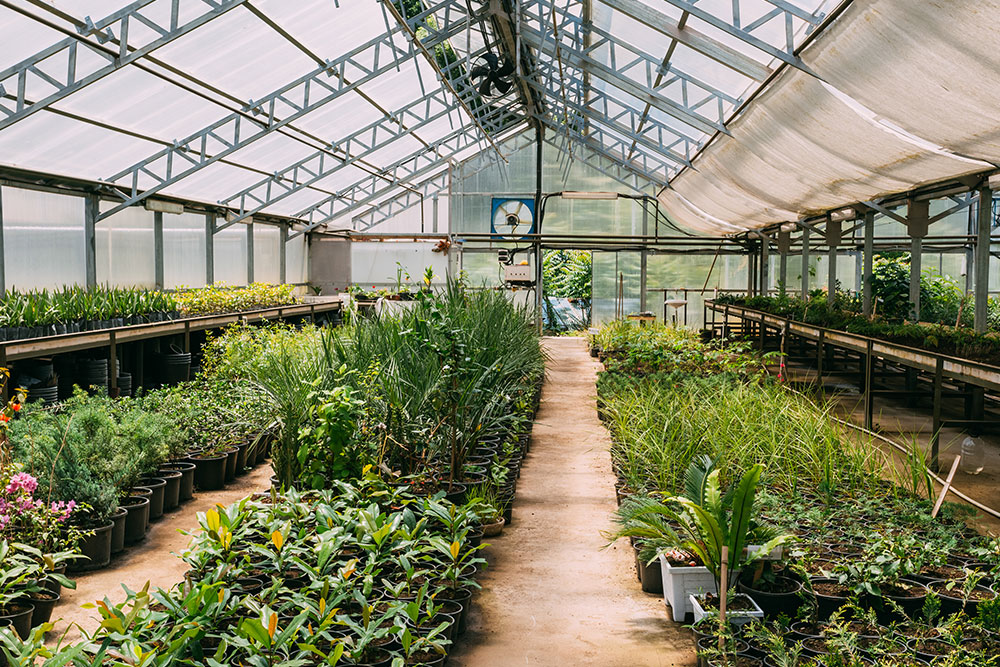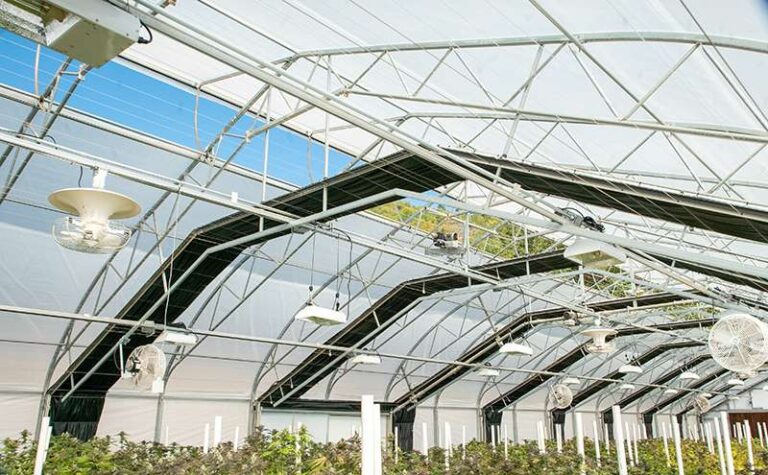Setting up a fully automated greenhouse involves various costs, contingent on factors like size, technology, location, and desired automation level. Infrastructure expenses encompass the greenhouse’s physical structure, spanning from basic constructions of a few thousand dollars to commercial-grade structures that may cost hundreds of thousands or even millions.
Climate control systems for temperature, ventilation, and cooling, essential for optimal growing conditions, can range from a few thousand to tens or hundreds of thousands depending on sophistication.
Water and irrigation systems, lighting for year-round production, automation technology for monitoring and control, and associated labor and energy costs add to the overall investment.
How does Technology Power Fully Automated Greenhouses?

These components work synergistically in a fully automated greenhouse, leveraging advanced technology and infrastructure to create an environment conducive to optimal plant growth, while reducing manual labor and resource wastage.
Technology used for automation
Sensors
- Types of sensors used: temperature, humidity, light, CO2, soil moisture, etc.
- Functions: Monitoring environmental conditions within the greenhouse.
- Importance: Sensors provide real-time data crucial for automated decision-making processes.
Control systems
- Types of control systems: Programmable Logic Controllers (PLCs), computer-based systems, IoT devices.
- Functions: Regulating various parameters based on sensor data, controlling irrigation, ventilation, heating, and cooling systems.
- Importance: Control systems automate tasks, ensuring precise and timely adjustments to maintain optimal growing conditions.
Robotics
- Types of robots used: Automated harvesters, plant manipulators, drones for monitoring.
- Functions: Performing tasks like planting, harvesting, pruning, and monitoring crops.
- Importance: Robotics minimizes manual labor, enhances efficiency, and enables precise operations, contributing to higher yields.
Infrastructure required
Climate control mechanisms
- Heating systems: Furnaces, heaters, or geothermal heating to maintain optimal temperatures.
- Cooling systems: Fans, evaporative cooling, or air conditioning to control excessive heat.
- Importance: Maintaining the ideal climate for plant growth regardless of external conditions, ensuring year-round production.
Irrigation systems
Drip irrigation, hydroponics, or aeroponics systems used for water and nutrient delivery.
Automated watering schedules based on sensor data.
Efficient water usage, delivering nutrients directly to plants, reducing water waste and enhancing crop health.
Monitoring and data analysis tools
Software platforms, AI algorithms, or machine learning models for data analysis.
Remote monitoring systems for real-time observation and analysis of greenhouse conditions.
Provides insights into crop health, growth patterns, and predictive analytics for better decision-making, optimizing resource utilization.
What Factors Impact Fully Automated Greenhouse Costs?
Knowing about these different costs is really important when planning and budgeting for setting up and looking after fully automated greenhouses. It helps in making smart decisions for spending money, both at the start and for running the greenhouse in the long term.
Technology and equipment expenses
Sensor and control system costs
High-quality sensors capable of accurate readings can be quite costly, particularly when accounting for various types such as temperature, humidity, light, among others. Additionally, advanced control systems, such as IoT-based or AI-driven platforms, often require a substantial initial investment and ongoing subscription or licensing expenses.
The prices of these systems can fluctuate based on their sophistication, brand, and scalability, contributing to cost variations among available options.
Robotics and automation machinery costs
The initial investment in robotics tailored for tasks like planting, harvesting, and monitoring can be significant due to the cutting-edge technology involved. Besides, maintenance requirements and software updates further add to the ongoing costs of these systems.
However, conducting a cost-benefit analysis demonstrates that while robotics may pose higher expenses at the outset, they can result in long-term cost savings through reduced labor expenses and enhanced efficiency.
Construction and infrastructure expenses
Building materials and design
Using high-quality materials that are weather-resistant and tailored for the greenhouse environment can raise construction costs. Customized designs or specialized structures intended for seamless integration of automation technologies might demand additional engineering and design expenditures.
These cost considerations are crucial as building materials and design significantly impact the overall durability, efficiency, and functionality of the greenhouse.
Installation and setup costs
The professional installation of automation systems, sensors, and robotics necessitates skilled labor and specialized expertise, contributing to setup expenses. Integrating diverse components and systems within the greenhouse may lead to additional costs.
Furthermore, training expenses incurred for staff to proficiently operate and maintain the automated systems contribute to setup expenditures.
Operational costs
Energy consumption
The operation of automation systems, climate control mechanisms, and robotics demands a consistent power supply, resulting in increased energy consumption. Although the adoption of renewable energy sources like solar or wind power can potentially reduce long-term operational costs, their implementation involves upfront investment.
Emphasizing efficiency considerations is crucial to optimize systems for energy use and mitigate ongoing operational expenses.
Maintenance and repairs
Regular maintenance of sensors, control systems, robotics, and infrastructure is indispensable for ensuring optimal performance. The costs associated with repairing malfunctioning equipment or unexpected breakdowns contribute to operational expenses. Implementing strategies such as predictive maintenance and warranties can minimize repair costs in the long run.
Labor costs for specialized skills
The need for skilled technicians and engineers to install, operate, and troubleshoot automated systems adds to labor costs. Continuous training programs to update and upgrade staff skills are essential, further influencing ongoing operational expenses.
What Cost-Benefit Analysis applies to Fully Automated Greenhouses?

The cost-benefit analysis of fully automated greenhouses showcases not only economic advantages through increased productivity and reduced labor costs but also significant environmental benefits.
Economic advantages
Increased productivity and yield
Precision control of environmental factors (temperature, humidity, light) optimizes plant growth, leading to higher yields. Automated systems ensure consistent care and monitoring, reducing crop losses due to human errors or inconsistent management practices.Higher yields translate into increased revenue and profitability for greenhouse operators.
Reduced labor costs in the long term
Automation of tasks such as planting, harvesting, and monitoring minimizes the need for manual labor. Initial investment in robotics and automation machinery leads to decreased dependency on manual labor over time. Lower labor costs contribute to improved operational efficiency and cost savings in the long run.
Improved resource utilization
Efficient use of water, nutrients, and energy through precise monitoring and automated delivery systems. Optimization of resources based on real-time data and analytics reduces waste and increases resource efficiency. Lower resource consumption per unit of output leads to cost savings and sustainability benefits.
Environmental benefits
Reduced water usage
Precision irrigation systems deliver water directly to plants, minimizing wastage.
Sensors and control systems optimize water usage by adjusting irrigation based on plant needs and environmental conditions.
Environmental impact: Conservation of water resources and reduced strain on water supplies.
Lower carbon footprint
Automated climate control systems optimize energy use and reduce greenhouse gas emissions. Adoption of renewable energy sources for powering automated systems decreases reliance on fossil fuels.
Reduced energy consumption and reliance on non-renewable resources contribute to a lower carbon footprint.
Minimized pesticide use through precision agriculture
Sensors and data analysis tools enable early detection of pests and diseases, allowing targeted intervention. Precision application of pesticides using automated systems reduces overall chemical usage.
Reduced pesticide usage minimizes environmental pollution and preserves ecosystem health.
FAQ’s
What is the most profitable greenhouse product?
The profitability of greenhouse products varies, but certain high-value crops like tomatoes, peppers, and herbs can often yield higher profits.
Is greenhouse software profitable?
Greenhouse software can be profitable as it streamlines operations, improves efficiency, and helps in better decision-making, resulting in potential cost savings and increased productivity.
Do greenhouses save money?
Yes, greenhouses can save money in the long run by optimizing resources, reducing wastage, and improving crop yields, thereby enhancing overall profitability.
Do greenhouses use a lot of energy?
Greenhouses do require energy for climate control and operations, but advancements in technology enable more efficient energy use, potentially reducing overall energy consumption.
Do greenhouses make plants grow faster?
Yes, controlled environments in greenhouses, with optimal conditions like temperature, humidity, and light, often result in faster and healthier plant growth compared to open-field cultivation.
What makes a greenhouse successful?
A successful greenhouse relies on factors like proper planning, efficient resource management, advanced technology integration, skilled management, and a suitable crop selection for the market demand.
Final Words
In conclusion, fully automated greenhouses bring many good things. They help plants grow better, save money on labor, and use resources wisely. These greenhouses also help the environment by using less water, creating fewer emissions, and reducing the need for pesticides.
Even though they can cost a lot to set up, they give back in the long run by making more crops and saving money. Looking ahead, these high-tech greenhouses seem like a great way to grow food in a smarter and more eco-friendly way.

